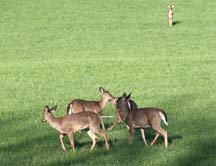Hunting gives deer-damaged forests in Indiana state parks a shot at recovery
July 9, 2014
 |
|
White-tailed deer browse in rural West Lafayette. |
WEST LAFAYETTE, Ind. - Regulated deer hunts in Indiana state parks have helped restore the health of forests suffering from decades of damage caused by overabundant populations of white-tailed deer, a Purdue study shows.
A research team led by Michael Jenkins, associate professor of forest ecology, found that a 17-year-long Indiana Department of Natural Resources policy of organizing hunts in state parks has successfully spurred the regrowth of native tree seedlings, herbs and wildflowers rendered scarce by browsing deer.
Jenkins said that while hunting may be unpopular with some, it is an effective means of promoting the growth and richness of Indiana's natural areas.
"We can't put nature in a glass dome and think it's going to regulate itself," he said. "Because our actions have made the natural world the way it is, we have an obligation to practice stewardship to maintain ecological balance."
Indiana state parks historically did not allow hunting. But by the 1990s, white-tailed deer populations in parks had swelled to such size that many species of native wildflowers such as trillium and lilies largely disappeared, replaced by wild ginger and exotic species such as garlic mustard and Japanese stiltgrass, plants not favored by deer. Oak and ash tree seedlings gave way to highly deer-resistant or unpalatable trees such as pawpaw.
The health of deer in state parks also dwindled as their food sources shrank.
To check the overabundant deer populations, the DNR introduced controlled hunts in state parks in 1993, with most parks adopting the strategy by 1996.
"Hunting in natural areas is controversial," Jenkins said. "But when deer are overabundant, they start to have undeniable negative impacts on the ecosystem."
Working with Christopher Webster, a Michigan Tech University professor and Purdue alumnus, Jenkins and then-master's student Lindsay Jenkins (no relation) tested the effectiveness of the hunting program by comparing the amount of plant cover in 108 plots in state parks and historically hunted areas with 1996-97 levels. They found that total plant cover in state parks more than doubled from 1996-97 to 2010. Herbs such as asters, violets and goldenrods increased from about 20 percent to 32 percent cover, and percent cover of grasses rose from 1 to 3 percent. Tree seedlings jumped from about 2 percent to about 13 percent of total plant cover, a finding that suggests when older trees die out, there will be younger trees to replace them, Jenkins said.
"With heavy populations of deer, tree seedlings often don't have a chance to survive," he said. "In those situations, the forest could lose its ability to reproduce itself and eventually cease to be healthy."
The study also showed that the hunting program led to the recovery of native species and discouraged the spread of invasive and exotic species, said Lindsay Jenkins.
"We saw a striking improvement in the quality and diversity of the forest understory in state parks compared with conditions before the hunting program," she said. "The deer management program is having a clear, beneficial impact on Indiana parks and could serve as a good example for nature preserves with overabundant deer in other states."
The study was published in Biological Conservation and is available at http://www.sciencedirect.com/science/article/pii/S0006320714001736.
Purdue's Department of Forestry and Natural Resources' John S. Wright Endowment provided funding for the research.
Writer: Natalie van Hoose, 765-496-2050, nvanhoos@purdue.edu
Sources: Michael Jenkins, 765-494-3602, jenkinma@purdue.edu
Lindsay Jenkins, jenkins.944@osu.edu
ABSTRACT
Herbaceous layer response to 17 years of controlled deer hunting in forested natural areas
Lindsay H. Jenkins 1; Michael A. Jenkins 1; Christopher R. Webster 2; Patrick A. Zollner 1
1 Department of Forestry and Natural Resources, Purdue University, 715 West State Street, West Lafayette, IN 47907-206, USA
2 School of Forest Resources and Environmental Science, Michigan Technological University, 1400 Townsend Drive, Houghton, MI 49931, USA
E-mail: jenkinma@purdue.edu
Deleterious effects of overabundant deer populations within natural areas have been well documented, and hunting programs have been initiated to control populations and facilitate the recovery of vegetation communities. However, few studies have examined whether recovery has occurred following sustained hunting. Hunting was initiated during the 1990s to reduce overabundant deer populations in Indiana state parks. In 2010, we resampled 108 plots established in 1996/97 across 15 state parks and five historically-hunted reference areas to quantify changes in herbaceous-layer vegetation. Species cover was measured along three, 10 m line transects nested within each plot. Data were pooled for all parks and reference areas. We calculated species richness (S), evenness (E), and Shannon-Weiner diversity (H') in 1996/97 and 2010. Compositional changes between sample intervals and contemporary composition across environmental gradients were examined using nonmetric multidimensional scaling (NMS). We observed greater increases in herbaceous-layer cover in parks than in reference areas. S and H' increased significantly in parks, but not reference areas. NMS ordinations revealed unidirectional changes in species composition between parks and their respective reference areas with the composition of parks becoming more similar to that of reference areas through time. Park size, cumulative deer harvest, initial deer abundance, and recent average of harvest/hunter effort were significantly correlated (p < 0.05) with ordination scores in four out of five natural regions ([r] > 0.5 for at least one axis). Browse-sensitive functional groups increased in cover while that of exotic species decreased. Changes were most pronounced for tree seedlings, which displayed a sixfold increase in cover within parks between sample intervals. These results suggest that hunting has allowed recovery of degraded vegetation communities.
Ag Communications: (765) 494-2722;
Keith Robinson, robins89@purdue.edu
Agriculture News Page

